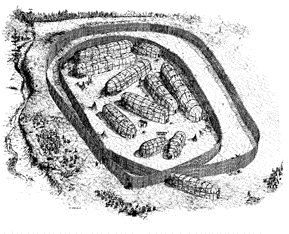The term “Iroquoian” refers to a shared culture and a linguistic family (with varying dialects) to which the Wendat belong. It is not to be confused with “Iroquois” — an Algonquian word used to refer to the Haudenosaunee Confederacy.
The earliest written descriptions of Northern Iroquoian communities include palisaded settlements with bark-covered longhouses and fully developed maize horticulture supported by hunting, fishing, and gathering.
Labour was divided by gender, the social structure was organized around matrilineal clans, and political organization included village, nation and confederacy councils. At times, there was warfare between nations and/or confederacies.
The Wendat were the northernmost of the Iroquoian societies and their Confederacy consisted of four allied nations: the Attignawantan (Bear), the Attigneenongnahac (Cord), the Arendarhonon (Rock) and the Tahontaenrat (Deer). The name “Wendat” is interpreted as “islanders” or “the people of the peninsula.” Iroquoian peoples referred to the world as “Turtle Island,” which referred to the turtle’s back upon which Sky Woman (“Aateantsic” in Wendat, meaning “Ancient One”) landed in the creation story.
“Wendake” is the term used to describe the ancestral land of the Wendat people. It is traditionally defined as the land between Lake Simcoe, Georgian Bay and Lake Ontario. Wendake is the current name of the home of the Huron-Wendat Nation, located near Québec City.


